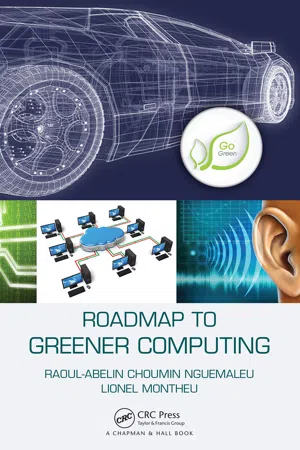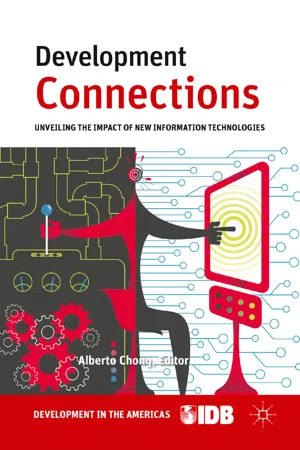Computer Science
Environmental Impact of Computers
The environmental impact of computers refers to the negative effects that the production, use, and disposal of computers have on the environment. These impacts include the depletion of natural resources, the emission of greenhouse gases, and the generation of electronic waste. It is important to consider these impacts and take steps to reduce them through sustainable practices and responsible disposal.
Written by Perlego with AI-assistance
Related key terms
1 of 5
3 Key excerpts on "Environmental Impact of Computers"
- Adele Kuzmiakova(Author)
- 2020(Publication Date)
- Arcler Press(Publisher)
The world as we know today has many different problems occurring within at a time. The environment is under threats from many different factors including the climate. Climate change has become one of the major issues affecting the environment as of today. Many organizations are working on finding out ways to reduce the level of global warming. Computers have advanced to a level that allows us to utilize them to make some of these changes. Figure 10.1: There are many different ways in which computer science and technology can be integrated into different aspects so as to improve the environ-ment. Source: http://myelectronicsblog.blogspot.com/2008/12/green-computers-and-computing.html. How Has Computer Science and Technology Changed ... 235 The number of natural disasters that are occurring in the world have increased by four times since 1970. This is mostly due to a rise in the global temperature that or happens annually. In addition to the rise in the global temperature, there has also been an increase in air pollution, forests being cut down and also bush fires, greenhouse omissions have increased, carbon dioxide omissions have also increased, and many other contributors to the state of the environment now as we know it. These changes in the environment are affecting many different aspects including the fishing farming, crop farming, livestock farming, etc. all of which are very important in providing both a livelihood and food for the growing population. This being said there are many scientists who are working to reduce or reverse the effects that have occurred, and they are using supercomputers to do so. Below we will discuss all the different ways in which computer science and technology can be utilized in the environment. 10.2. REDUCING THE LEVEL OF PLASTIC POLLU-TION Every year, around 14,000,000 tons of plastic is dumped in our water bodies. In comparison, one can imagine a fully filled garbage truck dumping all its trash into the ocean every single minute.- eBook - PDF
- Raoul-Abelin Choumin Nguemaleu, Lionel Montheu(Authors)
- 2014(Publication Date)
- Chapman and Hall/CRC(Publisher)
Such undertakings are possible thanks to services like voice over internet proto-col (VoIP: internet phone calls), streaming (watching movies and listening to music online), social networking, and much more. The availability of these services relies heavily on strong IT infrastructure. Although we benefit from the possibilities that computers offer, we are also negatively affected by the impact of IT infrastructure on our environ-ment. The lifecycle of IT infrastructure consists of manufacturing, pur-chasing, use, and disposal/recycling. In this work, we will examine why and how these lifecycle phases affect our environment. We will also pro-pose concrete solutions that can help make the lifecycle of IT infrastruc-ture more environmentally friendly. On the Way to Eco-Friendly Computer Infrastructure ◾ 3 1.2 MANUFACTURING COMPUTER COMPONENTS The initial phase in the lifecycle of computer components is their manu-facture. As early as this point, the choice of adequate materials and chemi-cals can impact the environment positively or negatively. 1.2.1 Current Situation Figure 1.1 is an illustration of a desktop computer with its basic compo-nents such as a keyboard, monitor, mouse, and the tower hosting the cen-tral processing unit (CPU). The numbered elements show where various toxins can be found in per-sonal desktop computers [1] or in computers used in corporations. Next we describe the negative effects of computer infrastructure on human health. 1.2.1.1 Lead Many older TV and computer monitors contain lead, which is also used in soldering of circuit boards. Exposure to lead [2] can be through the inha-lation of lead dust or fumes, ingestion of lead-contaminated food or water, or through contaminated hands, cigarettes, or clothing. When lead enters the respiratory and digestive systems, it passes into the blood and is dis-tributed throughout the body. Following contamination, more than 90% of the total body burden of lead accumulates or is stored in bone. - eBook - PDF
Development Connections
Unveiling the Impact of New Information Technologies
- Inter-American Development Bank, A. Chong(Authors)
- 2011(Publication Date)
- Palgrave Macmillan(Publisher)
ICT’S IMPACT ON THE ENVIRONMENT 217 ICTs: Mitigate, Monitor, Adapt ICTs span a wide range of technologies with exceedingly diverse uses, from e-mail to cell phones to mapping software for geo- graphic information systems (GIS). Thus, it is not surprising that the relationship between ICTs and the environment is multidi- mensional. Building on prior analyses (Labelle, Rodshcat, and Vetter, 2008; Houghton, 2009; Ospina and Heeks, 2010), this chapter adopts a framework for conceptualizing the relationship between ICTs and the environment that identifies three main categories of environmental impact: mitigation, monitoring, and adaptation. Mitigation refers to reducing the degrading impacts on the environment. Monitoring refers to the potential for ICTs to collect and distribute important environmental information. Adaptation refers to people’s ability to adapt and respond to cli- mate change, which may include making pro-environmental behavior changes. Mitigation: On Both Sides of the Environmental Equation ICTs have two contrasting effects within the area of mitiga- tion. The first is the direct (negative) effect of the ICT sec- tor’s own environmental footprint. One example is electronic waste, created by the growing quantity of discarded techno- logical devices. The second effect is the indirect (positive) effect of ICTs, or ways in which ICTs can mitigate environ- mental impact in other sectors. Indirect effects include “dema- terialization,” such as the effect of e-mail and online media that replace physical consumption with virtual consumption. Indirect effects also include “smart” ICT devices designed to reduce energy consumption, such as lights designed to dim automatically in empty rooms. 218 DEVELOPMENT CONNECTIONS The SMART 2020 report of the Global e-Sustainability Initiative (GeSI) estimates that in 2007, the ICT sector was responsible for 2 percent of total carbon emissions, or 830 million tons (Mt) of C0 2 (GeSI, 2008).
Index pages curate the most relevant extracts from our library of academic textbooks. They’ve been created using an in-house natural language model (NLM), each adding context and meaning to key research topics.


